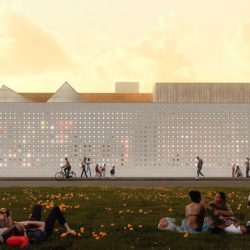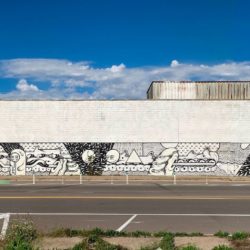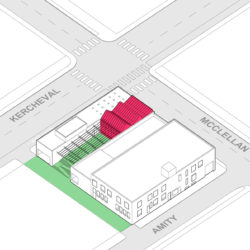
Located in a former commercial bakery and warehouse in Detroit’s East Village, Library Street Collective’s new mixed-use arts hub is a revitalization of an existing industrial building—composed of three connected structures on a single parcel built at different times with each addition simpler than the building before it. Two local artist non-profits, Signal-Return and Progress Arts Studio Collective (PASC); affordable artist studios and art gallery; neighborhood serving, creative retail; and a communal outdoor public space will occupy the renewed, 22,300 square foot building.
Signal-Return and PASC will occupy approximately 8,500 square feet of the complex. PASC is an art studio and exhibition program dedicated to supporting adults with developmental disabilities and mental health concerns. Signal-Return is a nonprofit dedicated to preserving and teaching traditional letterpress printing. While different in disciplines and the communities they serve, both integrate art education, production, display, and retail to engage with and provide for the community.
_

OMA’s approach takes advantage of the building’s current state of disrepair, transforming an area missing both its roof and an end wall into a courtyard at the heart of the building. Defined as the primary entry with multiple frontages for all tenants, the courtyard becomes a public, accessible gateway and an activity condenser. Signal-Return and PASC’s diverse set of programs—art education, production and display—are organized within and across the existing structures to maximize points of access and potentials for community interface. Production zones and artist studios create an active and inviting face to Amity Street; galleries line the courtyard to reinforce a public heart for the building; and neighborhood serving functions are orchestrated on the opposite side of the courtyard to consolidate the most public amenities along Kercheval Avenue.
The existing, bricked or boarded up openings will be opened strategically. Operable windows are inserted at the studios to allow for ventilation; gallery windows are extruded to become art vitrines; and larger openings offer indoor-outdoor potentials for production spaces. The south building faces the intersection of two prominent streets, Kercheval and McLellan, but is currently a solid expanse of concrete masonry (CMU). Rather than imposing a new composition of windows, 1,500 holes will be drilled into the blank CMU walls and filled with cylindrical glass blocks. This monolithic field of openings will subtly reveal activities within and become a glowing lantern at night.
_
















